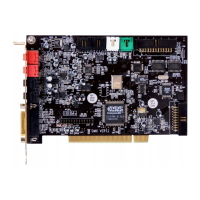SoundSystem DMX 69
3D Audio Today
Today, you and developers have available powerful technology which, with the help of clever
algorithms, can make what was recorded with costly microphony hearable and controllable.
The basis for this are: runtime, and phase/frequency shifts in the audio signal. This means
that depending on when and in which acoustical environment a specific frequency reaches our
ear, our hearing interprets a respective position (of the echoing object or our relative position
to it). Reflectors of echo waves as well as their absorption play an important role here, i.e.,
how strongly frequencies change when they "rebound" from other bodies, before they reach
our ears. Meanwhile, even these conditions can be well-simulated.
No to be confused with with "real" 3D audio, there are many other forms of simulated room
sounds such as, for example, (older) versions of Q Sound™, V Space or the surroundswitch on
the TV at home. This deals with the simple widening of the stereo basis (sounds wider – but
also somewhat mushy) – no special experience of aha. However, multi-chanal playback
systems such as Dolby ProLogic™ or Dolby AC3™ are also not the end-all solution because:
using 4 or more speakers with these procedures are positions the audio signal between the
boxes and doesn't simulate the distance for the listener – whether it be flat or vertical (up and
down). A real 3D audio system allows two things: first, the positioning of sounds in a virtual
room and second, the targeted movement (interaction) of an audio object.
Perfect?
As was stated above, hearing is only one way of making "virtual worlds" partially real.Our
eyes also have a part in how we "understand" our environment. And also extremely low
frequencies which we find alarming help us recognize objects, for example, ("Watch out! tank
on the left ...").
For this our brain accesses our vast experiences to evaluate a situation: imagine a door that is
closing and you hear the proper accompanying sound. But if you hear something like a
slamming noise, then you know something is amiss ...
"Perfect" becomes the reflection of our environment through a combination of different
playback systems. And naturally there are still a lot of hurdles to be overcome in the subject
of 3D audio as there are with capable graphics systems. In any case the basics have been
discovered in the meantime, the algorithms found, the standard practice proven – it is now
"only" a question of computer capabilities and optimization. We are at the end of our brief
crash course, remember performance-wise no one will be able to challenge your SoundSystem
DMX for the foreseeable future ... have fun!

